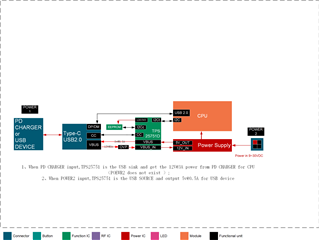Tool/software:

1. Can TPS25751 be applied to the following scenarios? When the ROUTER is a SINK, it needs to be powered by USB-PD at 12V-3A, and the ROUTER has no battery. When the ROUTER is a SOURCE, it has other external power supplies and needs to discharge 5V 0.5A externally. It supports external devices such as USB flash drives.
2. Can TPS25751 + EEPROM negotiate a power of 12V-3A or more independently with the charger when there is no main control working?
3. How to operate the EEPROM burning method? Is the software compilation and burning done by Ti or the customer? How to burn the software specifically?
4. Can the 3.3V power supply of TPS25751 directly use the 5V/12V power supply of VBUS without external power supply?
5. What is the relationship between VBUS_IN and VBUS?
Please help answer our five questions based on this block diagram.








